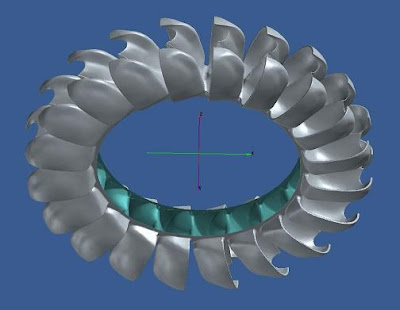The Francis turbine is a type of water turbine that was developed by James B. Francis. It is an inward flow reaction turbine that combines radial and axial flow concepts. Francis turbines are the most common water turbine in use today. They operate in a head range of ten meters to several hundred meters and are primarily used for electrical power production.
Theory of Operation
The Francis turbine is a reaction turbine, which means that the working fluid changes pressure as it moves through the turbine, giving up its energy. A casement is needed to contain the water flow. The turbine is located between the high pressure water source and the low pressure water exit, usually at the base of a dam.The inlet is spiral shaped. Guide vanes direct the water tangentially to the turbine wheel, known as a runner. This radial flow acts on the runner's vanes, causing the runner to spin. The guide vanes (or wicket gate) may be adjustable to allow efficient turbine operation for a range of water flow conditions. As the water moves through the runner its spinning radius decreases, further acting on the runner. For an analogy, imagine swinging a ball on a string around in a circle; if the string is pulled short, the ball spins faster due to the conservation of angular momentum. This property, in addition to the water's pressure, helps Francis and other inward-flow turbines harness water energy efficiently.
Application
Francis turbines may be designed for a wide range of heads and flows. This, along with their high efficiency, has made them the most widely used turbine in the world. Francis type units cover a head range from 20 meters to 700 meters, and their output power varies from just a few kilowatts up to one gigawatt. Large Francis turbines are individually designed for each site to operate at the highest possible efficiency, typically over 90%. In addition to electrical production, they may also be used for pumped storage; where a reservoir is filled by the turbine (acting as a pump) during low power demand, and then reversed and used to generate power during peak demand.


